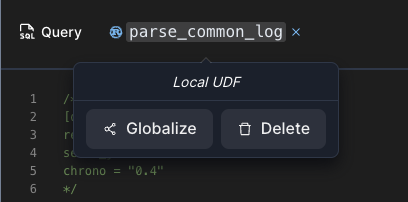TEXT BYTEA in SQL), UDFs use the reference type
(&str and &[u8]) for arguments and the owned types (String and Vec<u8>)
for return values.
Arroyo UDFs are annotated with the #[udf] in the arroyo_udf_plugin crate if they
are written in rust and the @udf decorators if you use Python. UDFs can be defined
as part of the SQL API call, or via the Web UI.
Here’s an example of a simple UDF that squares an integer:
Creating UDFs
UDFs are developed and managed in the Web UI, within the Pipeline editor. To create a new UDF, navigate to the UDFs tab and click “New.”
#[udf] for Rust or @udf for Python. You may include helper
functions, structs, and other definitions so long as only one function has the
udf annotation.
As you’re developing, you may make use of the “Check” button to validate the UDF
definition. Any Rust compilation or Python parsing errors will be included in
the errors box at the bottom of the UI.
Global UDFs
UDFs may be either local—associated with a particular pipeline—or global, in which case they are stored in the database and may be used in any pipeline. All UDFs begin as local. If you’ve written a UDF that will benefit from being globally available, you can make it global by hovering over the tab containing the UDF, and clicking the “Globalize” button in the drop down.
Performance considerations
UDFs are expected to run and return quickly (think microseconds, not milliseconds). This means they shouldn’t do any blocking work (like making network requests) or CPU-intensive computations. Within the Arroyo dataflow, UDFs are treated as normal scalar functions. They run serially against a batch of data, and while they run forward progress is blocked. If you need to use IO, CPU-intensive computations, or other usecases for long-running UDFs, see async UDFs.Debugging UDFs
If UDFs panic, they will produce log lines in the worker logs. These are not currently forwarded to the Web UI, so you will need to find the logs where the workers are running. For the defaultprocess scheduler, this will be in the
controller logs. For the kubernetes scheduler, this will be within the actual worker pods.